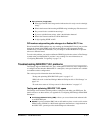
APPENDIX E
APPENDIX E
INTEL DIALOGIC TELEPHONY BOARD
S
PECIFICATIONS
Important: For the most up-to-date list of Intel telephony boards and specifications, refer to the
Excel version of the information contained in this appendix (SupportedTelephonyBoards.xls),
included on the root directory of the Intel Dialogic Drivers CD. Note that not all Intel telephony
boards are supported by the SU 107 drivers included with TeleVantage 7.5. If you have older
unsupported boards, you will need to either replace them or use the SU 69 drivers included with
TeleVantage 7.
Note: If you are viewing the online book version of this manual (InstallingIntel.chm), you must
refer to the spreadsheet, because the tables are not included in the online book.
This appendix contains the same information, broken out into the following tables:
Basic Board Information. See page E-1.
Trunk Resource by Board. See page E-2.
Station and Other Resources by Board. See page E-3.
You can use the board specifications to determine which boards your system requires based on
how you plan to use TeleVantage, for example the number and types of trunks you plan to use,
the number and types of phones you need to support, conference requirements, and so forth.
For more information on how TeleVantage uses Intel Dialogic telephony boards, see the
following:
Chapter 4, “Intel Dialogic Telephony Hardware and Software Requirements”
Appendix A, “Voice and Conference Resource Usage in TeleVantage”
Basic Board Information table contents
This table contains the following basic information for each supported telephony board:
Column Description
Board Model number
DM3 Type of Intel Dialogic telephony board.
Yes: Board is a DM3 board. DM3 boards have special requirements
and configuration needs, as described in Chapter 7 in Installing Intel
Dialogic Components.
No: Board is not a DM3 board.


















